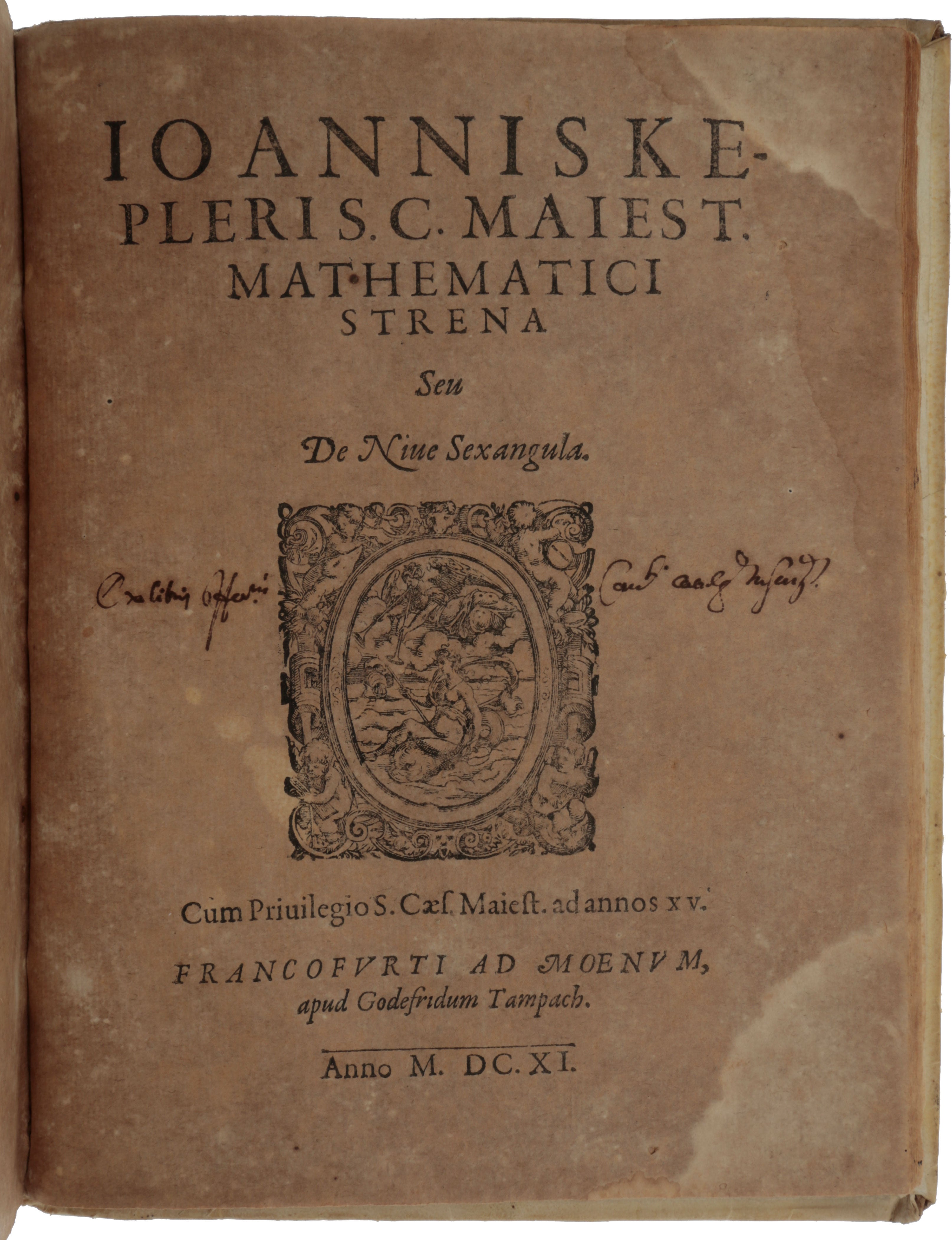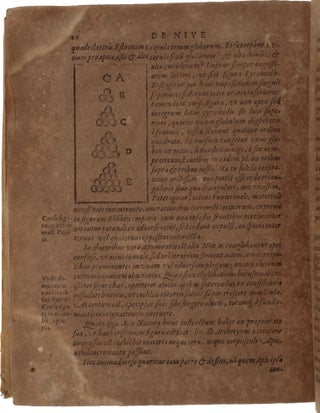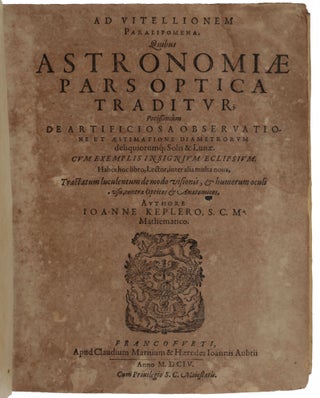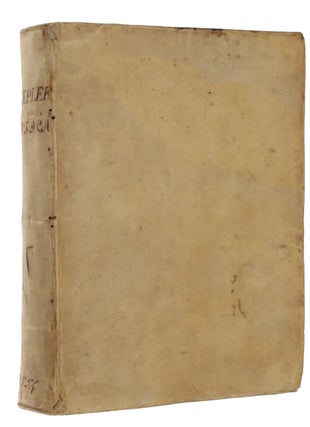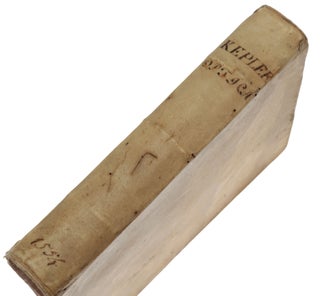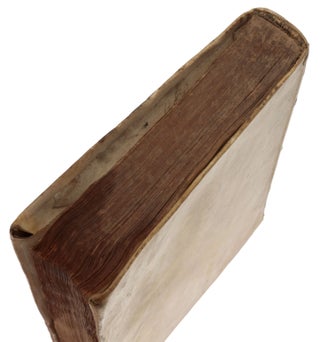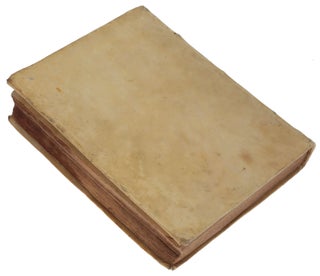Strena seu de nive sexangula.
Frankfurt: Godefrid Tampach, 1611. First edition, extremely rare, of the first scientific treatise on crystallography. Written in the form of a letter, this small tract was presented to Kepler’s friend at court, Matthäus Wackher von Wackenfels (who had informed Kepler of the discoveries Galileo had made with the telescope in 1610). “It is not only a charming letter, light-hearted and full of puns, but also a perceptive, pioneering study of the regular arrangement and the close packing that are fundamental in crystallography” (DSB). “Crossing the bridge over the Moldau in a snowstorm, [Kepler] noticed the snowflakes falling on his sleeve. Being nearsighted, he could closely observe their hexagonal form, each snowflake different from the others, yet all six-sided. His roving mind, always filled with curiosity, began to reflect on the causes behind their pattern. What resulted was a little booklet, a New Year’s gift for a friend, the charming tract that is now considered one of the pioneering works in theoretical mineralogy” (Gingerich 2010, p. 10). “Kepler’s attempt to understand the hexagonal structure of snowflakes in terms of the packing of globules has been hailed as a revolutionary anticipation of molecular models, and its effect on Peiresc, Gassendi, Mersenne, Descartes, the Bartholinus brothers, Rossetti, Grew, Hooke, and on the general history of crystallography is well documented” (Lefèvre et al, p. 129). Strena begins with a typically humanist, playful jeu de mots, suggesting that he is sending “some nothing” (nihil), a pun on the equivalent German word nichts, which is pronounced the same as the Latin word nix, meaning snow. Its serious content is a discussion of snow crystals and their hexagonal structure. “Why is it,” Kepler asks, “that when we see snowstars (stellulae nivales) they are always hexagonal, and never pentagonal or heptagonal?” “The specific answer lay a few centuries in the future [in the molecular structure of ice], but Kepler’s fertile theological imagination saw a direction towards a solution, a ‘formative faculty’ at work in the universe, a concept that he would develop in both his Epitome of Copernican Astronomy and his Harmonice mundi” (Gingerich 2010, pp. 10-11). “Until very recently, the literature on snow crystals was concerned almost exclusively with description and classification of the main crystal forms and very little with the mechanisms of growth and the factors that might determine shape and form. In that he clearly posed the problem, and proposed several alternative explanations of the hexagonal symmetry of snow crystals, Kepler’s contribution remained almost unique for 300 years” (Mason, p. 51). In the course of this study, Kepler is led to formulate ‘Kepler’s conjecture,’ on the most efficient way to pack equal spheres in space. This was one of the greatest unsolved problems in mathematics, the 18th of the problems David Hilbert presented to the mathematical world at the International Congress of Mathematicians in 1900. It remained unproved until 1998. ABPC/RBH record the sale of four copies since Honeyman, of which two were in modern bindings. OCLC lists four copies in US (Columbia, Cornell, Linda Hall, Smithsonian). Johannes Kepler (1571-1630) came from a very modest family in the small German town of Weil der Stadt. He studied at the University of Tübingen under the astronomer Michael Maestlin. In 1594 he moved to Graz in Austria to take up a position as provincial mathematician. It was there that he wrote his first great work, Mysterium cosmographicum (1596), “the first unabashedly Copernican treatise since De revolutionibus” (DSB), which explained the known number of planets (six) and the diameters of their orbits in terms of nested Platonic solids. Forced out of Graz by religious controversy, Kepler moved to Prague in January 1600, a few months after Tycho Brahe had arrived in the same city to join the court of Emperor Rudolph II. “The encounter between the young German theoretician and the famous Danish observer turned the course of astronomy … within two years Tycho had died and his full set of observations, although claimed by his heirs, fell into Kepler’s hands” (Gingerich 1971). The first fruit of this legacy was Kepler’s discovery of his first two laws of planetary motion, published in 1609 in Astronomia Nova. Kepler also inherited Brahe’s position as Court Astronomer. “After the publication of his Astronomia Nova, Kepler could at last have a period of quiet and happiness. As the Court Astronomer he was well considered and had every facility in the beautiful and flourishing imperial city of Prague, which, under the reign of Rudolph II, was playing an important role in European politics. By taste, the shy Rudolph II encouraged crafts, arts, and sciences; a general climate of mixed humanism, science and mysticism reigned. There was a well developed court life, and Kepler had several patrons and friends among the intellectuals, court officials and nobility. The most prominent and loyal of these was the imperial councilor Baron Johannes Matthäus Wackher von Wackhenfels (1550-1619), humanist and diplomat. At New Year 1611, Kepler presented his friend with the Strena seu de nive sexangula, “A New Year’s Gift of Hexagonal Snow.’ Behind the banter there is a deep mathematical and geometrical cogitation in this little essay. It deals with the symmetry of the snowflakes and attempts to explain their regularity by the regular geometrical arrangement of identical minute pellets. It also shows how Kepler’s mind balanced between the old Aristotelian view of Nature and the new physical description and explanation of phenomena” (Authier, p. 282). “Kepler recognized that snowflakes are composed of several individual units brought together, as he thought, by irregular drifting and that each individual always possesses six corners and not five or seven. In this he differed (correctly) from Descartes, who held roughly the inverse view, that the hexagonal unit was evolved by a partial melting of an agglomeration of identical particles. Kepler realized that the six-sidedness could not be inherent either in the water vapour or in the coldness of the air, but discussed whether it was imposed by an external factor and arose perhaps because the hexagon was a particularly suitable or efficient form. This led him to a consideration of ways of filling space with repetitive figures and to the idea that natural structures such as bees’ honeycombs and pomegranates achieve their shape from necessity. He discusses, for the first time, cubical and hexagonal close-packing of equal spheres” (Mason, p. 51). Kepler writes: “Now if you proceed to pack the solid bodies as tightly as possible, and set the files that are first arranged on the level on top of others, layer on layer, the spheres will be either squared, or in triangles. If squared, either each single sphere of the upper range will rest on a single sphere of the lower, or, on the other hand, each single sphere of the upper range will settle between every four of the lower. In the former mode any sphere is touched by four neighbours in the same plane, and by one above and one below, and so on throughout, each touched by six others. The arrangement will be cubic, and the spheres, when subjected to pressure, will become cubes. But this will not be the tightest pack. In the second mode not only is every sphere touched by its four neighbours in the same plane, but also by four in the plane above and by four below, and so throughout one will be touched by twelve, and under pressure spherical spheres will become rhomboid. This arrangement will be more comparable to the octahedron and pyramid. This arrangement will be the tightest possible, so that in no other arrangement could more spheres be stuffed into the same container” (Hardie, with ‘pellet’ changed to ‘sphere’). “Kepler suggested that a pomegranate needs to store the maximum number of seeds in the smallest possible space, so that hexagonal close-packing is not only the most efficient method, but is also a material necessity. But he also saw that such arrangements were not necessarily applicable to a flat snow crystal and, having argued convincingly that such a form is highly unlikely to result from the reduction of a regular three-dimensional aggregate of snow, even if this were composed of regularly packed rows of globules, Kepler went on to discuss space-filling in two, rather than three, dimensions. He thought that the flatness of the snow crystal might be explained in terms of the cold meeting the warm vapour at a plane interface, but then asked why it should be six-cornered. Regular hexagons can fill two-dimensional space without gaps but so can equilateral triangles and squares. In any case, it is possible to fill space completely with hexagons only if they are of the same size and, as Kepler points out, snowflakes are not of the same size. “In short, after considering several possible explanations for preference of the hexagon, Kepler remains unconvinced by any of them, and finally ponders on the possibility that it may arise from a formative faculty in the body of the Earth, and be formed as part of the Creator’s design because of its aptness and beauty. But, even so, he admits that Nature produces other shapes in other crystals and so is finally unable to arrive at a satisfactory explanation for the hexagonality of snow. “Although Kepler was unable to offer a satisfactory explanation of the six-sidedness of the snowflake, his discussions of space-filling and symmetry laid the early foundations of crystallography. He discusses, in print, for the first time, the ordered symmetrical shapes that arise from the packing together of similar bodies, which may themselves lack symmetry. The Pyramids bear witness to the fact that man has long been aware of the superstructures that can be built from the stacking of repeated geometrical units. This awareness was revealed later by the three-dimensional stacking of spheres in the work of the early goldsmiths and in the piling of cannon balls, but the relationship of these models to the minute geometry of matter was not recognized until Kepler’s time … “In two dimensions, space can be filled with identical polygons in only three ways: by triangles meeting six at each corner, by quadrangles meeting four at each corner, or by hexagons joining in groups of three at every point in the array. This was clearly recognized by Kepler. The most economical subdivision of two-dimensional space – that which minimizes the total length of the boundaries between a given number of regular cells – is the hexagon. “In three-dimensional space, however, the simplest symmetrical unit, the cube, is not the simplest nor the most economical space-filling unit. The cell with the minimum number of junctions is the truncated octahedron. That which gives the minimum interfacial area is obtained from a truncated octahedron by introducing double curvatures into the hexagonal faces so that all faces meet at a dihedral angle of 120°. “Kepler’s essay contains both aspects of the space-filling problem. The stacking of spheres is a case of symmetrical groups arising through point contacts. The structure of the pomegranate and the bees’ honeycomb may be discussed in terms of stacked polyhedra. Kepler’s was the first explicit statement of the fact that an aggregate of uniform spheres in contact is symmetrical only along certain directions, the units themselves having no directional properties. “But Kepler did not think of the spheres as atoms. Indeed, it was not until the end of the nineteenth century, long after the concept of the atom had been accepted, that the packing units in crystals were identified with the constituent atoms. It seems that the crystal and the atom developed as quite separate concepts. While mineralogists had long identified and classified crystals by their angles, it was a long time before shape was associated with chemical composition and before the importance of internal order was realized. The chemists completely failed to recognize that constancy of composition would result from atoms arranged in continuous array until this was demonstrated conclusively by X-ray diffraction” (Mason, pp. 51-53). It is fitting that the discoverer of X-ray diffraction (1911), Max von Laue, in the Historical Introduction to the International Tables for X-ray Crystallography in 1952, called attention to this earliest observation of the connection between crystallographic regularity and atomism, and acknowledged in this way our debt across the centuries to Kepler. Laue notes that “it was the appearance of these regular and beautifully shaped snowflakes rather than the appearance of the crystals of the mineral world that inspired Kepler with the idea that this regularity might be due to the regular geometrical arrangement of minute and equal brick-like units … Nevertheless, Kepler felt uneasy about these speculations. He realised, quite correctly, that his way would lead to an atomic theory; yet the idea of the atom, as handed down from the ancient Greeks, lacked an empirical foundation and therefore has often been the subject of excessively fanciful speculation even until well into the nineteenth century. Hence it was not without reason that the natural scientist in Kepler mistrusted this idea and would not take it seriously.” Kepler’s statement quoted above, that the arrangement “will be the tightest possible, so that in no other arrangement could more spheres be stuffed into the same container”, is what is called the ‘Kepler conjecture.’ This states that the most efficient packing of equal spheres is constructed by setting layers of spheres, one upon another. Each layer is a regular pattern of spheres in a grid of equilateral triangles, and the spheres in each successive layer sit in gaps in the preceding layer. There are in fact two ways to place each layer in gaps in the preceding layer, so there are many packings all with the same efficiency – in all of them the proportion of space occupied by the spheres is p/Ö18 (approximately 0.74048). Placing every third layer in the same position gives the face-centred cubic packing; the other well-known case is ‘hexagonal close packing,’ in which every alternate layer is the same. Kepler’s conjecture remained unproved for almost four centuries until in 1998 Professor Thomas Hales of Michigan University, together with his student Samuel Ferguson, announced that they had proved the conjecture. The proof is extremely long (282 pages!) and requires extensive computer calculations, and it was therefore a challenge to test its correctness. It was not published until 2005, but is now generally accepted by the mathematical community. The present copy of Strena is bound after an incomplete copy of Kepler’s Ad Vitellionem paralipomena, quibus astronomiae pars optica traditur (Frankfurt: Claude Marne and the heirs of Jean Aubry, 1604), considered the foundation work of modern optics. “Working within the perspectivist tradition of Alhazen, Roger Bacon, Witelo, John Pecham, and others, Kepler accepts that sight is possible due to rays emitted from visible objects, with these rays emitted in all directions from each point on the object’s surface. He overcomes a major shortcoming of the earlier theories by establishing a logically acceptable one-to-one correspondence between the points on the observed portion of the object and the points on the image produced on the surface of the eye’s retina; instead of rejecting all rays hitting the eye non-perpendicularly, as Alhazen had done, Kepler argues that all the rays incident on the eye from any specific point on the object will arrive at a single point on the retina after refraction in the eye’s humours. In consequence, the retina receives an unfocussed, although inverted, image of the object. Kepler also presents experimental results, examining, for instance, the range of applicability of Ptolemy’s direct proportionality between the angle of incidence and the angle of refraction; and he formulates the principle that the intensity of illumination is inversely proportional to the square of the distance from the illuminating source” (Parkinson, Breakthroughs, p. 62). “Kepler’s interest in optics arose as a direct result of his observations of the partial solar eclipse of 10 July 1600. Following instructions from Tycho Brahe, he constructed a pinhole camera; his measurements, made in the Graz marketplace, closely duplicated Brahe’s and seemed to show that the moon’s apparent diameter was considerably less than the sun’s. Kepler soon realized that the phenomenon resulted from the finite aperture of the instrument; his analysis, assisted by actual threads, led to a clearly defined concept of the light ray, the foundation of modern geometrical optics … Kepler intended at first to publish his optical analyses merely as Ad Vitellionem paralipomena, but by 1602 this ‘Appendix to Witelo’ had taken second place to the broader program of Astronomiae pars optica. The book was published in 1604 with both titles … The six astronomical chapters include not only a discussion of parallax, astronomical refraction, and his eclipse instruments but also the annual variation in the apparent size of the sun … The immediate impact of Kepler’s optical work was not great, but ultimately it changed the course of optics” (DSB). Caspar 39; Cinti 30; Roller & Goodman II, p. 34. Authier, Early Days of X-ray Crystallography, 2013. Gingerich, ‘Johannes Kepler and the Rudolphine Tables,’ pp. 328-333 in: Sky and Telescope 42, 1971. Gingerich, ‘The delights of a roving mind,’ in: Nims, The Six-Cornered Snowflake, 2010. Lefèvre et al., The Power of Images in Early Modern Science, 2003. Mason, ‘On the shapes of snow crystals,’ pp. 47-56 in: The Six-Cornered Snowflake (Hardie, ed. & tr.), 1966. For an account of Kepler’s conjecture and its proof, see George Z. Szpiro, Kepler's Conjecture: How Some of the Greatest Minds in History Helped Solve One of the Oldest Math Problems in the World, 2003.
Two works bound in one vol., 4to (199 x 157 mm). Strena: pp. [3], 4-24, three small woodcut diagrams in text and woodcut device on title page, printed marginalia; Ad Vitellionem: pp. [xvi], 449, [19], the two folding tables lacking (some browning throughout as usual with these works due to the quality of the paper, light damp-stain to upper right corner). Eighteenth-century vellum, hand-written title on spine.
Item #4960
Price: $75,000.00

